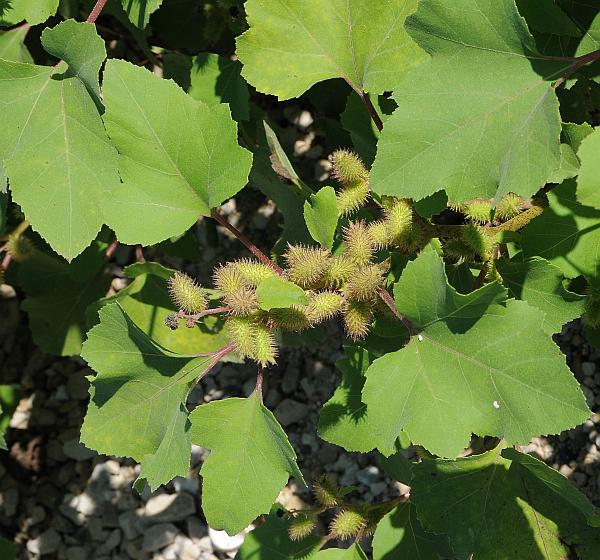Xanthium strumarium L.
Cocklebur

Native
CC = 0
CW = 0
MOC = 86
© SRTurner
Xanthium strumarium L.Cocklebur | |
 |
Native CC = 0 CW = 0 MOC = 86 |
© SRTurner |
|
Family - Asteraceae/Heliantheae Habit - Taprooted annual forb. Stems - Ascending, to 1.5 m, branching above, nearly glabrous to moderately roughened-pubescent with short, stout, broad-based, ascending hairs and often also with minute glandular hairs or inconspicuous, sessile glands, spineless.
Leaves - Alternate, simple, mostly long-petiolate. Leaf blades 2-18 cm long, broadly ovate or ovate-triangular to more or less kidney-shaped or nearly circular, mostly shallowly to deeply cordate at the base (often broadly short-tapered to the petiole within the notch), variously rounded to bluntly or sharply pointed at the tip, unlobed or with 3 or 5 usually shallow, broad, palmate main lobes, the margins otherwise coarsely and irregularly toothed, the surfaces sparsely to moderately roughened with short, stout, loosely appressed, broad-based hairs, sometimes only along the veins, usually also glandular.
Inflorescences - Separate staminate and pistillate heads in small, dense axillary spikes (the uppermost spikes sometimes entirely staminate, the lowermost spikes occasionally entirely pistillate), the staminate heads usually several toward the tip of the spike, the pistillate heads usually solitary or in a small cluster of 2-4 at the base of the spike, each subtended by a small bract.
Heads - Discoid. Involucre of the staminate heads 2-4 mm in diameter, saucer-shaped, symmetrical, the 6-18 involucral bracts in 1-3 series, free to the base, green. Pistillate heads mostly 2-4 per spike. Involucre of the pistillate heads with the main body ellipsoid, the involucral bracts several to numerous in several overlapping series, closely enclosing the florets and all but the outermost few fused into a sharp, hooked bur, usually 2-beaked at the tip (where an opening allows exsertion of the stigma), green, turning brown to orangish brown or brownish yellow at fruiting. Receptacle conical in staminate heads, impossible to observe in pistillate heads, with chaffy bracts subtending the florets.
Flowers - Staminate heads with 20-60 disc florets, these with a minute, nonfunctional ovary and undivided style, the stamens with the filaments more or less fused into a tube and the anthers free but positioned closely adjacent to one another in a ring, the corolla 1-2 mm long, narrowly bell-shaped to nearly tubular, shallowly 5-lobed, white to pale yellow, sometimes purplish-tinged toward the tip, usually minutely hairy and often also glandular. Pistillate heads with 2 florets in separate chambers, the corolla absent. Pappus absent. Fruits - Achenes 8-11 mm long, narrowly elliptic to narrowly oblanceolate in outline, somewhat flattened with rounded angles, grayish brown to dark gray or black, nearly smooth or more commonly with noticeable branched veins, glabrous, often somewhat shiny, completely enclosed in the persistent pistillate involucre and dispersed as an intact bur.
Flowering - July - November. Habitat - Streambanks, swamps, sloughs, bottomland prairies, bottomland forests, pond margins, marshes, fens, seeps, fields, crop fields, pastures, barnyards, ditches, railroads, roadsides, open disturbed areas. Origin - Native to the U.S. Lookalikes - None. Other info. - This familiar species is found across Missouri, is common in nearly every state of the continental U.S., and occurs nearly worldwide. Though it is native in the U.S., it is considered a noxious weed in many states, particularly in the Southeast. It is easily recognized by the characteristic burs. These are the pistillate flowering heads, which have hooked spines as the involucral bracts. Each bur contains two flowers, which are are virtually invisible, and which later give rise to the large, black achenes. The encasing involucre persists as the achenes mature, its hooked spines eventually providing a convenient aid for dispersal. Photographs taken at Shaw Nature Reserve, Franklin County, MO, 10-16-2005, Riverfront Park, Washington, Franklin County, MO, 9-15-2018 and 9-16-2020, near Labadie, Franklin County, MO, 9-3-2019, and along the Katy Trail near Treloar, Warren County, MO, 9-26-2020 (SRTurner). |